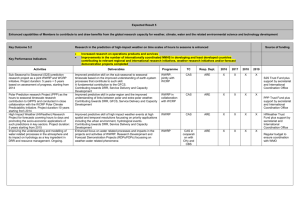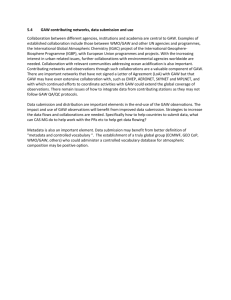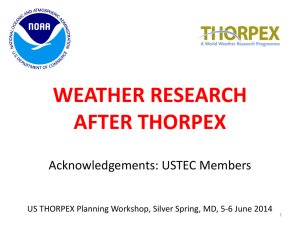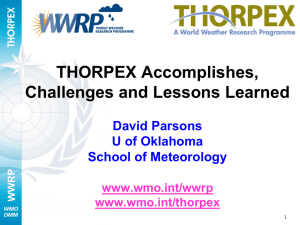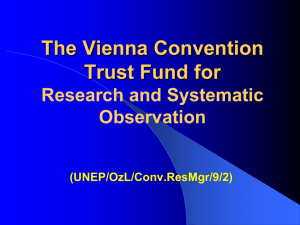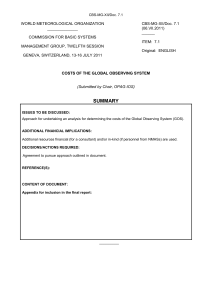Atmospheric Research and Environment Programme
advertisement
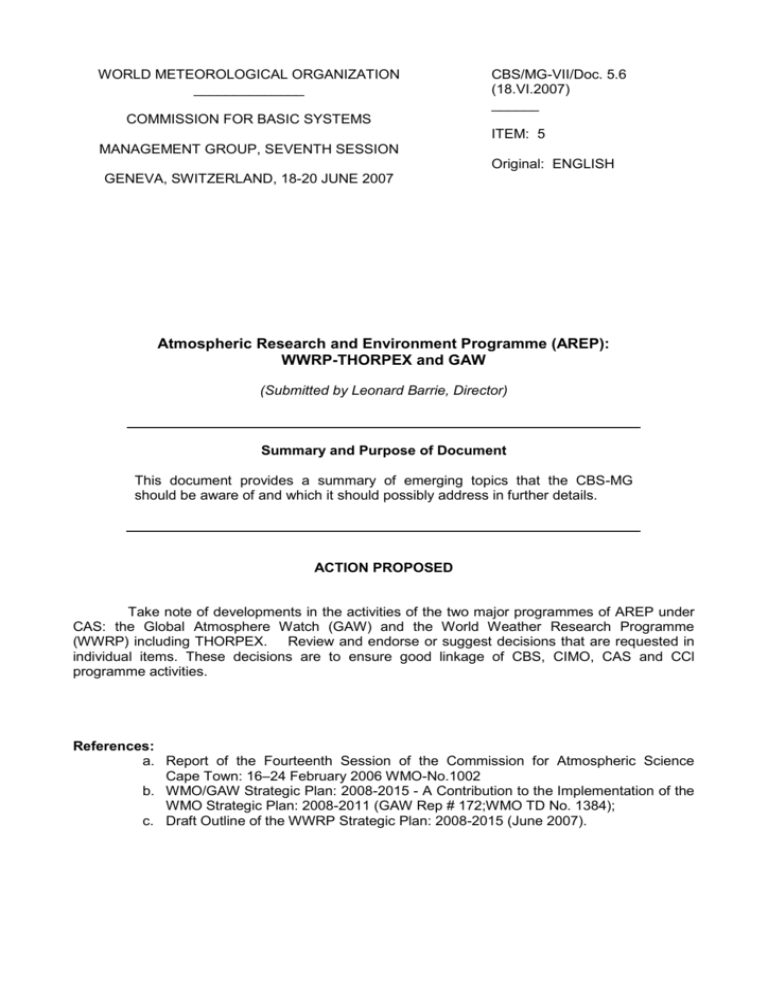
WORLD METEOROLOGICAL ORGANIZATION ______________ CBS/MG-VII/Doc. 5.6 (18.VI.2007) ______ COMMISSION FOR BASIC SYSTEMS ITEM: 5 MANAGEMENT GROUP, SEVENTH SESSION Original: ENGLISH GENEVA, SWITZERLAND, 18-20 JUNE 2007 Atmospheric Research and Environment Programme (AREP): WWRP-THORPEX and GAW (Submitted by Leonard Barrie, Director) Summary and Purpose of Document This document provides a summary of emerging topics that the CBS-MG should be aware of and which it should possibly address in further details. ACTION PROPOSED Take note of developments in the activities of the two major programmes of AREP under CAS: the Global Atmosphere Watch (GAW) and the World Weather Research Programme (WWRP) including THORPEX. Review and endorse or suggest decisions that are requested in individual items. These decisions are to ensure good linkage of CBS, CIMO, CAS and CCl programme activities. References: a. Report of the Fourteenth Session of the Commission for Atmospheric Science Cape Town: 16–24 February 2006 WMO-No.1002 b. WMO/GAW Strategic Plan: 2008-2015 - A Contribution to the Implementation of the WMO Strategic Plan: 2008-2011 (GAW Rep # 172;WMO TD No. 1384); c. Draft Outline of the WWRP Strategic Plan: 2008-2015 (June 2007). CBS-MG-07/Doc. 5.6, p.2 DISCUSSION 1. The AREP GAW and WWRP-THORPEX programmes and structure have evolved considerably since the Fourteenth Session of CAS in February 2006 in South Africa (Reference a) and subsequent meetings of the WMO Executive Council and Congress. The new Open Programme Area Group structure adopted by CAS XIV was easily adapted to the GAW programme without major change. It is now overseen by the CAS Joint Scientific Steering Committee for the OPAG on Environmental Pollution and Atmospheric Chemistry (EPAC). In contrast, the World Weather Research Programme (WWRP) including the trust-funded activities of THORPEX has undergone major changes as directed by CAS XIV. It is overseen by the CAS Joint Scientific Committee for the OPAG on WWRP. Linkages with other WMO programmes under CBS, CIMO and CCl as well as with co-sponsored programmes such as WCRP and GCOS are high priority for CAS and AREP. CBS considered the suggestion that future meetings of CBS, CAS and CIMO management groups should, if possible, be coordinated so as to ensure maximum interaction and reduce costs of expert travel. It decided ……. 2. The GAW programme focusing on ozone/UV, aerosols, greenhouse gases, reactive gases and precipitation chemistry is a key component of the WMO Integrated Observing Systems (WIGOS) that complements GOS, the backbone of WMO observational systems for classic meteorological variables. The rationale and roadmap for GAW is described in detail in the technical Strategic Plan for 2008-2015 (Reference b). In contrast to GOS, GAW has emerged from a community of operational research institutions that are both inside and outside the NMHSs and largely as a climate-type observational system. However, now with the impending incorporation into NWP models of aerosols, ozone and their precursor gases, there is a need to deliver some of these observations in near real time. CBS MG welcomed the recognition by CAS and AREP that NRT delivery of GAW variables should be done through the GTS part of WIS and that other data management components of GAW should be clearly linked to WIS. It endorsed the idea of a GAW/WIS pilot project under oversight of CBS and CAS to expedite NRT delivery of aerosols and ozone as part of CG XVs request to develop an observing system of systems. 3. In June 2006, EC LVIII (parag 3.3.1.4) concluded: “ In response to the request for a proposal to fill the programmatic gap in WMO global radiation measurements made by EC-LVII (3.3.2.6), a WMO Ad-hoc Inter-commission Group, meeting on 78 June 2006 in St. Petersburg, unanimously agreed that there is a lack of oversight of WMO global radiation observations that needs to be addressed by a Panel of Experts that complements the excellent technical support provided by the CIMO Expert Team on Observations of the Meteorological Radiation and Atmospheric Composition Measurements. The Panel should oversee all components of the Global Surface Radiation Network, including traceability of calibration, technical requirements, quality assurance management, network operation development and capacity building, data submission/archiving and linkage to a diverse community of practice. Noting that the World Radiation Data Centre is currently part of the GAW programme, the Council accepted the advice of the Ad-hoc Inter-commission Group and recommended the establishment of a Scientific Advisory Group for Radiation of the OPAC-EPAC under the Commission for Atmospheric Sciences (CAS) and that these changes are reflected in the GAW Strategic Plan: 2008-2015. Furthermore, it requested that the Secretary-General consider ways to adequately support from the general budget the new oversight group in the WMO GAW programme as well as the enhancement of appropriate on-going activities of the WMO WWW Programme under CBS and CIMO. “ In April 2007 the CAS JSSC OPAG-EPAC finalized the GAW Strategic Plan: 20082011 and resolved (under Chapter 8 on Solar Radiation) to continue to address this beginning with gap with the following Task: Task 8.1. Establish under appropriate leadership an inter-commission Scientific Advisory Group for Radiation with specific terms of reference and membership to address the CBS-MG-VI/ Doc 5.6 programmatic gap in GSRN oversight identified by the ad-hoc inter-commission expert team. (WMO, CAS, CIMO, CBS – 2008) Under the condition that : “implementation of these tasks is conditional upon appropriate resource allocation and the implementation of Task 8.1” CBS MG considered the situation and agreed to the suggestion to develop with CAS, CIMO and BSRN a proposal to the SG to support formation of a six person inter-commission” GSRN Scientific Advisory Group” for the limited period 2008-2011 using supplementary cross-cutting WIGOS budget funds. The group would then take specific steps to address the gaps in programmatic support outlined in the ad-hoc group report. 4. Following CAS XIV the World Weather Research Programme of WWRP has been reorganized under a new OPAG structure to include expert research groups on, THORPEX, Mesoscale Meteorology, Nowcasting, Tropical Meteorology, Verification Research and Societal and Economic Research Applications(SERA). The JSC OPAG-WWRP chaired by Gilbert Brunet is developing a technical WWRP Strategic Plan: 2008-2015 in the next year. The CBS Management Group will be requested to review this plan late this year or early 2008. A draft outline is in Appendix A of this document (Appendix A) 5 THORPEX is a WMO trust fund supported initiative overseen by an International Core Steering Committee(ICSC) chaired by David Burridge and, since the April 2007 JSC WWRP-OPAG and THORPEC-ICSC Meetings, administered by AREP through the Chief of World Weather Research programme. It focuses on three major projects as well as development of regional research plans. The THORPEX Interactive Grand Global Ensemble (TIGGE) is a prototype for a multi-model ensemble forecast system that would guide the development of a possible Global Interactive Forecasting System (GIFS). In its first phase, TIGGE would provide to all WMO Members near-real-time access to ensemble forecast products for research purposes. The second major project is the THORPEX Pacific Asian Regional Campaign (T-PARC). It is an important international research activity that would advance understanding of meteorology in the Pacific region and lead to better weather forecasts. The third project is the Year of Tropical Convection (YOTC). CAS MG welcomed the request by AREP and CAS to begin now to collaborate on the movement of TIGGE research products into operational tools through such mechanisms as Forecast Demonstration Projects. It suggested …….. 6. CG XV (Parag 3.3.3.6) endorsed the WWRP and GAW joint activity to create a WMO Sand and Dust Storm Warning System, aimed at coordinating observations and research forecast modelling of sand and dust storms while forging strong links with users including operational forecasters. Through WWW DPFS representation on an inter-programme ad-hoc group including agriculture meteorology, aviation meteorology, the ground work for moving operational research tools into NWP forecast operational products has been laid. CBS MG notes this development and requests that progress is reported at its next meeting. _______ CBS-MG-VI/ Doc 5.6 Appendix A Draft Outline of the WWRP Strategic Plan: 2008-2015 ( draft only June 2007) FOREWORD (Secretary General) EXECUTIVE SUMMARY 1. INTRODUCTION 1.1. The Rationale for WWRP including THORPEX (GB, MS and HD) 1.2. WWRP Mission (GB) 1.3. Main Long-Term Objectives (GB) 1.4. Implementation Strategy (GB, VW and ZL) 1.5. Implementation Principles (LB) 1.5.1 Added value 1.5.2 Criteria for projects 1.5.3 Linkage identified and insured (CBS …) 2. ORGANIZATIONAL COMPONENTS 2.1. The Structure of WWRP including THORPEX ( LB: Figure) 2.2. National Meteorological and Hydrological Services (NMHSs) ( ZL and LB) 2.3. Working Groups (General terms of reference) (LB) 2.4. Secretariat (LB) 2.5. WWRP Partners (LB) 3. WWRP RESEARCH ISSUES 3.1. Introduction (GB) 3.2. Predictability, Dynamical and Physical Processes (all working groups contributing) 3.3. Observing Systems and Strategies (all working groups contributing) 3.4. Data Assimilation (all working groups contributing) 3.5. Societal and Economic Applications (all working groups contributing) 4. WWRP RESEARCH ACTIVITIES 4.1 THORPEX Programme (MS, HD and JC) 4.1.1 Scope, Research Goals and Objectives 4.1.2 Structure of Working Groups (specific terms of reference) 4.1.3 Research Activities 4.1.4 Products ,Services and Technology transfer 4.1.5 Observing System Design and Optimization Research 4.1.6 Data Assimilation Research 4.1.7 Predictability and Dynamical Processes Research 4.1.8 Global Interactive Forecasting System (GIFS) & TIGGE 4.1.9 THORPEX Regional Campaigns (TReCs) 4.2. Nowcasting Research (TK) 4.2.1 Scope, Research Goals and Objectives 4.2.2 Working Group (specific terms of reference); links to WMO-APP/Nowcasting 4.2.3 Research Activities 4.2.3.1 Nowcasting Systems Research 4.2.3.2 Forecasting Demonstration Projects (FDPs) (e.g. Beijing, Vancouver etc) 4.2.4 Products, Services and Technology transfer 4.3 Mesoscale Weather Forecasting Research (JO and VW) 4.3.1 Scope, Research Goals and Objectives 4.3.2 Working Group (specific terms of reference) 4.3.3 Research Activities 4.3.3.1 Role of FDPs and RDPs, endorsement process, RDPs and FDPs for developing countries a) FDPs (MAP D- PHASE, Beijing 2008, etc.) b) RDPs (COPS, Vancouver 2010, etc.) 4.3.3.2 Links to other international activities (skill scores on the mesoscale, COPS, parameterizations, …) 4.3.3.3 Test-Beds Definitions, criteria, law issues, rules, endorsement process a) NOAA International. Hydrometeorological Testbed b) Helsinki Mesoscale Testbed 4.3.3.4 Products and Services Output of RDPs and FDPs Data exchange of RDPs and FDPs Technology transfer Transfer of RDP and FDP results to operational applications Data exchange of Testbeds Links to end users CBS-MG-VI/ Doc 5.6 4.3.4 Products, Services and Technology transfer 4.4 Tropical Meteorology Research (LC and RE) 4.4.1 Scope, Research Goals and Objectives 4.4.2 Working Group (specific terms of reference; links to other WMO TMR groups) 4.4.3 Research Activities 4.4.3.1 Tropical Cyclone Research 4.4.3.2 Monsoon Research 4.4.4 Products, Services and Technology transfer 4.5 Verification Research (BB) 4.5.1 Scope, Research Goals and Objectives 4.5.2 Joint WGNE/WWRP Working Group on Verification (specific terms of reference) 4.5.3 Research Activities 4.5.3.1 Research on New Verification Methodology 4.5.4 Products, Services and Technology transfer 4.5.5 Links to specific WWRP RDPs, FDPs and Test Beds 4.6 Societal and Economic Research and Applications (JL) 4.6.1 Scope, Research Goals and Objectives 4.6.2 Working Group (specific terms of reference; links to APP/S&E Group and to core activities groups 4.1 to 4.4) 4.6.3 Research Activities 4.6.3.1 Defining High-impact Weather Forecasts and Assessing their Value 4.6.3.2 Evaluating the Costs and Benefits of Improved Forecasts 4.6.4 Products, Services and Technology transfer 4.6.5 Support of WWRP-THORPEX Projects and Campaigns 5. CROSS CUTTING RESEARCH ACTIVITIES 5.1 T-PARC (DP) 5.2 TIGGE (PB) 5.3 The WMO Sand and Dust Storm Warning System (LB and SN) 5.4 Approaches to integrated forecasting systems (TK) 5.5 Climate, Weather and Interface (YOTC …) 5.6 IPY (TEN) 5.7 WWRP RDPs and FDPs (TK and VW) 5.8 Major Quadrennials Symposia and Workshops (LB, GB) 6. INTEGRATED APPROACH TO WEATHER, CLIMATE AND ATMOSPHERIC CHEMISTRY 6.1 Introduction (GB) 6.2 Organization and maintenance of organized tropical convection and interaction with the planetary circulation (WCRP/THORPEX …) (GB and CP Chang) 6.3 Seamless prediction with multi-model ensemble (TFSP, TIGGE) (GB) 6.4 Data assimilation as a prediction and validation tool for the climate and weather and a design tool for observation networks (WCRP/THORPEX…) (GB) (WCRP/THORPEX) (GB) 6.5 High-impact weather in observations and models (including Regional Climate Models) (WCRP/THORPEX…) (GB) 6.6 Atmospheric Chemistry and Weather (GEMS etc) (LB) 7. OUTREACH OF WWRP (DP and LB) 7.1 Transfer Research results to policy- and decision-makers 7.2 General Capacity Building 7.3 Catalogue of RDPs and FDPs (TK and VW) 8. RESOURCES 9. OUTLOOK REFERENCES LIST OF FIGURES AND TABLES ANNEX: ACRONYMS
